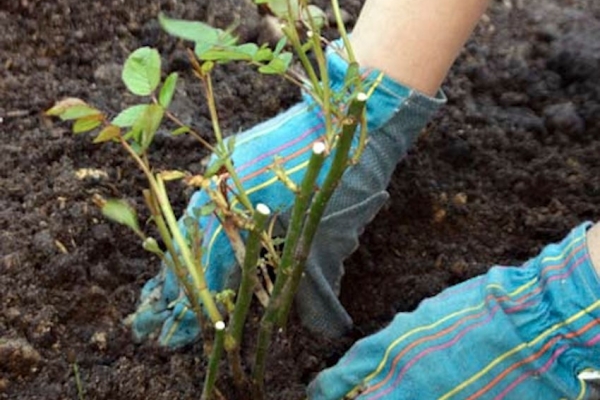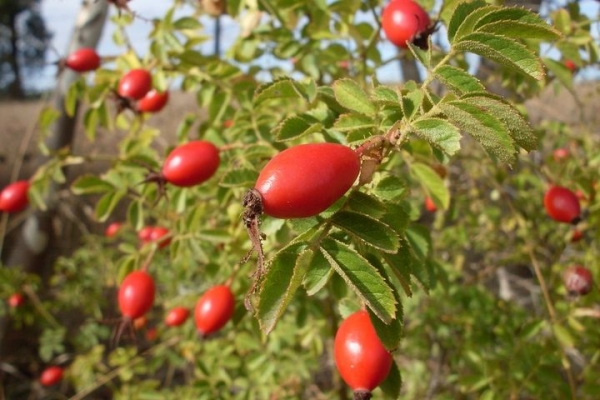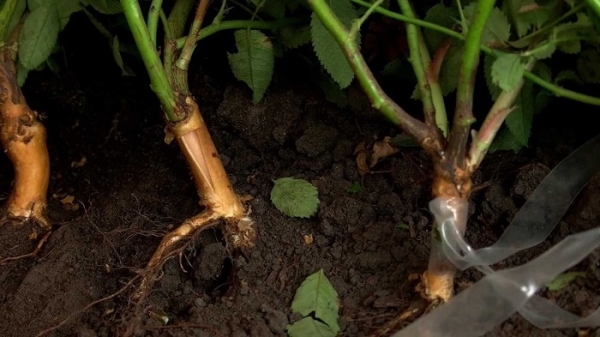Rosehip is a perennial shrubwhich belongs to the family Rosaceae. A prickly bush grows on forest edges, glades, on the slopes of beams, in river valleys. Also, this unpretentious shrub adorns the garden and dacha plots, since the unique berries are sources of minerals, vitamins and other trace elements that are vital for the human body. The article will consider the landing and care in open ground.
Table of contents
How to grow a garden rosehip from seed at home
The plant can be grown from seed. at home. There is an opportunity to control the whole process from beginning to end.
This method is simple and less laborious, differs from other methods in that it takes a long time.
Following the guidelines for growing wild rose from seed will allow you to grow such shrubs that will combine decoration and excellent fruiting performance.

Instructions for growing rose hips from seed:
- Seed material should be prepared accordingly, which will increase germination rates. For this purpose in August to collect not ripened, only slightly reddened fruits.
- Clean them from the pulp, wash, pour with wet sand and put in storage in a cold place. This will create conditions that are close to natural for their good growth.
- Plant in the fall, because during the winter period the seeds are better stratified.
- Sow seeds in open ground to a depth of 2 cm.
- Water and mulch with manure and sawdust.
- Spring sowing close with a film. To grow quickly air regularly.
- Remove the film with the onset of warm weather.
Need to remember about thinningas the plants should receive sunlight and food from the ground. Thin out after the appearance of the seedlings of three leaves.
We sow rosehip seeds:
Step-by-step guide to growing plants in open ground
When can be planted - in the fall or spring?
Rosehips are planted in the spring, before the beginning of the growing season, and in the autumn. For planting use annual and biennial seedlings.Landing steps include:
Determination of the place for landing
When choosing a place, it is necessary to take into account not only the aesthetic appearance of the garden plot, but also the needs of the plant for its normal development and yield. For this plant bushes in a well-lit area with fertile land.
Soil preparation before planting a bush
The main requirements for the soil is considered a thorough cleaning of weed crops and the accumulation of nutrients. The ground in the selected area must be perepakapa 20 cm.
Then dig holes for planting, the width and height of which should be half a meter. At the bottom of the recess make a small hill of fertile land.
How to plant ornamental shrubs
In order for the bush to take root well, you need to cut its roots a couple of centimeters, while it is long, they must be at least 25 cm. Before planting seedlings immersed in a talker of peat and manure. Landing pits well pour water.
Then lower the seedlings, straighten the roots and gently sprinkle with soil so as not to form voids. After that, tamp the ground around a young bush, water and grind with peat.
It is important that the distance between the bushes varied from 60 to 120 cm.

How to care for a thorny plant - the basic rules
Properly organized care helps to increase yields, improve palatability and accelerate fruit ripening. Therefore, the necessary measures should be carried out annually on a mandatory basis.
Optimal watering
Rosehip normally tolerates droughttherefore it does not need constant watering. The exception is hot, dry weather.
In this case, it is necessary to water the plant, using three buckets of water on young bushes, and five on fruit-bearing ones.
Basically, throughout the season, the procedure is carried out about four times.
Soil loosening
Proper care involves periodical loosening of the earth.
Still should constantly weed, destroying all the weeds that have grown near the bushes.
Forming a bush - pruning
Hips trimming is important as for decorative purposes, and for fruiting the bush. The first procedure should be performed immediately after disembarkation, cut off all the branches, leaving no more than three buds.
The next pruning should be carried out two years later, by removing the weak, broken branches on the ground. Healthy and powerful branches need to be cut at a height of 20 cm.
Pinch the tops to stimulate the development of side branches with flower buds, in shoots formed on stumps 75 cm high.

After three years, the berry crop will begin to bestow fruit.. By this age, shrubs should have about fifteen powerful evenly spaced and uneven-aged branches, since this berry crop is very fond of light, and the presence of many branches makes it difficult to plant flower buds.
The subsequent formation of the bush will consist in the elimination of broken, dry, diseased branches, weak shoots and the removal of branches that are more than five years old.
Pruning is carried out in the autumn, or in the spring until bud break.
Hips trimming:
Feed with appropriate nutrients and trace elements
For the best growth of wild rose shoots, it is necessary to provide it with all the nutrients in sufficient quantity. To this end, fertilizers are added using organic and mineral products.
Basal feeding is carried out four times a year.: before flowering and after, at the beginning of the ripening of the berries and after the harvest.
Preventive measures against diseases and pests
Rose hips planting attacks many pestswhich destroy aboveground and underground parts of it. Such pests include weevil, caterpillar moth, spider mite, rosy fly, and wild rose piedracidae.
Common Rose Hip Diseasepowdery mildew, rust, white and black spot is a significant harm to the bushes of the plant.
Therefore, in order for the berry crop to not be the center of the accumulation of pests and diseases, it is necessary to carry out protective procedures in a timely manner.
In the spring and autumn, cut dry and diseased branches, remove the fallen leaves, burn it, because under it can overwinter spores of fungi, as well as dig up near-trunk circles.

Inspect bushes regularly and, in case of detection of a problem, determine the type of the disease and treat it with appropriate special proven means.
In order to prevent process buds before bud break necessary drugs, in order to avoid the diseases inherent in this plant.
Preparing for the winter
Rosehip is considered a strong and winter-hardy plant.. Most of its varieties do not need shelter for the winter.
An exception may be young seedlings of decorative varieties that are sensitive to low temperatures and require reliable protection.
Compliance with all the rules for the care of the berry crop will allow you to get a rich harvest of medicinal, and most importantly environmentally friendly fruits.
Breeding methods, care
How to propagate wild rose? In addition to seeds, for planting wild rose also apply cuttings and layouts.
Propagate by green cuttings - cuttings
Rationally propagate cultivars and varieties of rosehip by cutting - green cuttings, which should be prepared in early July. During this period, the intensity of shoot growth decreases.
To do this, carefully cut the shoots and divide them into cuttings, so that each of them has three healthy growth buds. Leaflets located at the bottom should be removed, and the rest shortened by half.
Cut the top of the cutting straight, at a distance of 1 cm from the bud, and below cut the stem at an angle of 45 degrees.
Process cuttings for good education and root growth with specially designed growth stimulants. After that, planting material is transplanted into a pre-prepared substrate of peat and sand.
The root formation process lasts four weeks.. At first, take care - observe the irrigation regime and prevent the soil from drying out.

Grow by layering
Most gardeners prefer this method. breeding.This procedure is best performed from mid-spring until the end of summer. To do this, it is necessary to determine a productive shrub and separate young layers, whose height is equal to 30 cm.
Then plant on rooting. It is also possible not to separate, but to bend into the furrow 10 cm deep, pin it down and fill it with fertile soil. Regularly water, spud to avoid appearing adventitious roots.
Next fall, separate the young plant from the mother bush and trim the above-ground part at a height of 15 cm. In spring, you can dig up and put it in a permanent place.
Properly arranged planting and timely, properly performed care will allow to grow a green hedge from rose hips.
Which will not only add a special style to the site, will protect you from uninvited guests, but will also become an indispensable supplier of vitamins for the whole family.
